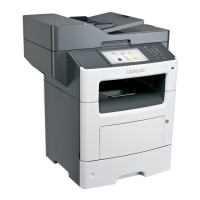Card stock
Card stock is a rigid, stiff material that can have a wide variety of constructions. Orientation of paper fibers (grain
direction), moisture content, thickness, texture, and other properties can significantly impact printing, as can
preprinting, perforation, creasing, and other features common to forms. For example, preprinting introduces
semi‑liquid, volatile components that must withstand the high temperatures used in laser printing. Perforation and
creasing may cause nesting, or interlocking, which can cause paper jams and double-sheet feeds.
In general, we recommend a single‑ply construction of 100% chemically‑pulped wood with a vellum finish. Before
purchasing large quantities of card stock, make sure you test samples of the print material in your printer.
Weight
The weight of card stock significantly affects the print quality and feed reliability of the stock. Specify the correct basis
weight of a stock. For more information, see “Basis weight” on page 9.
Basis weight is the weight in pounds of one ream, or 500 sheets, of paper. Since the sheet size varies from one type of
stock to another, basis weights are not always easily comparable. For example, an office supply store has 8.5 x 11‑size
cover stock (80 lb Bristol) and 8.5 x 11‑size card stock (90 lb Index) side by side on the shelf. Both papers are manufactured
by the same company, and a basis weight comparison indicates the card stock (90 lb Index) is heavier than the cover
stock (80 lb Bristol). In this case, however, the cover stock (80 lb Bristol) is actually heavier than the card stock (90 lb
Index).
Before the two types of paper were cut into 8.5 x 11‑size pages, the card stock was a larger sheet size than the sheet
size of the cover stock. When the papers were cut during the manufacturing process into 8.5 x 11‑size pages, more
reams (500 sheets) of paper were received from the card stock sheets than from the cover stock sheets. This makes
the weight of the cover stock heavier than the weight of the card stock.
It is easier to compare the cover stock metric weight (g/m
2
) against card stock metric weight (g/m
2
). If you look at the
metric weights of the two stocks in the previous example, it is immediately evident that 80 lb Bristol cover stock
(176 g/m
2
) is heavier than 90 lb Index card stock (163 g/m
2
).
Not all printers are able to print on cover stock. This is because cover stock is usually thicker and not able to make the
turns in the printer paper path. This causes paper jams and sometimes causes the paper to feed incorrectly. Also, when
using a laser printer, toner is pulled onto the paper through an electrical charge. If the paper is too thick, then there
may not be enough voltage to pull the toner onto the paper properly, resulting in poor print quality.
To determine if your printer supports cover stock, see the section for your printer in the "Printer specifications" chapter
and review the supported paper type information. You can also view the supported paper types in the documentation
that came with your printer.
Use the following table to compare the weights of various types of card stock.
Card stock 16

